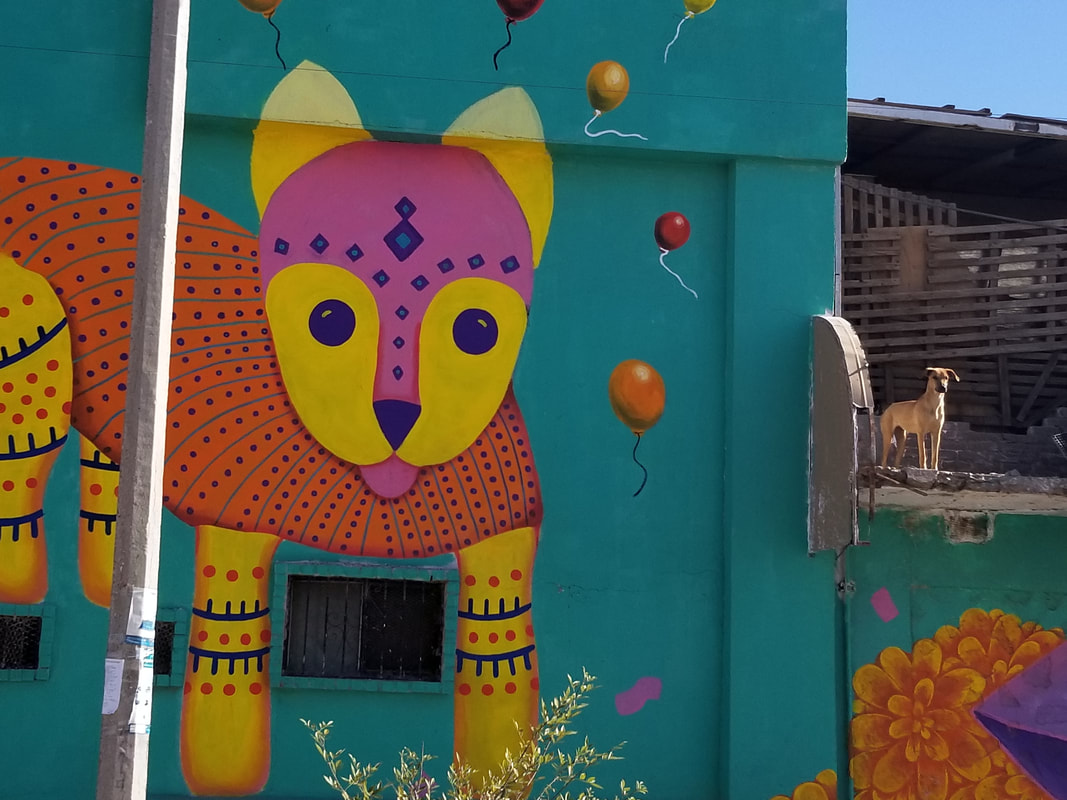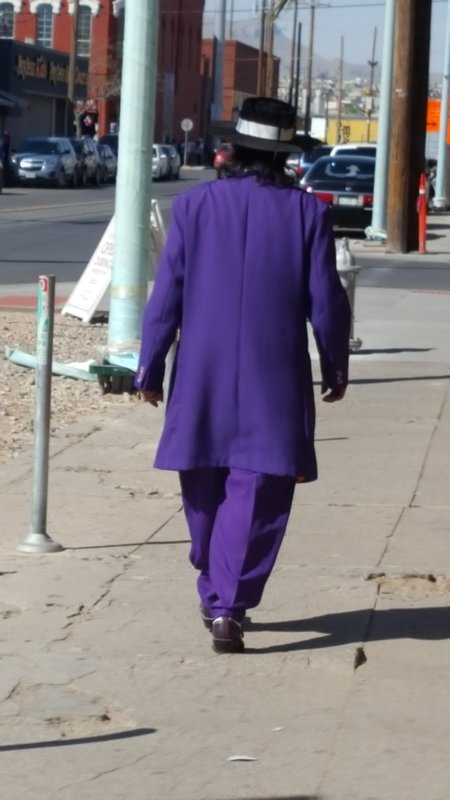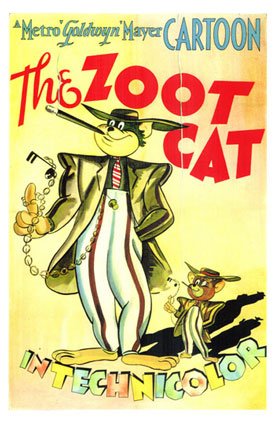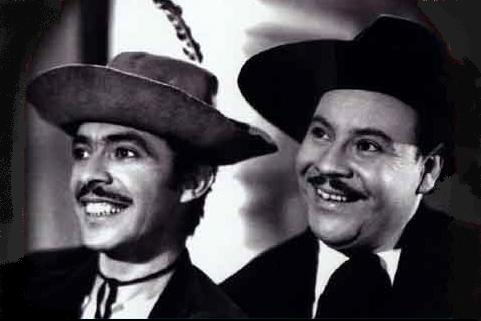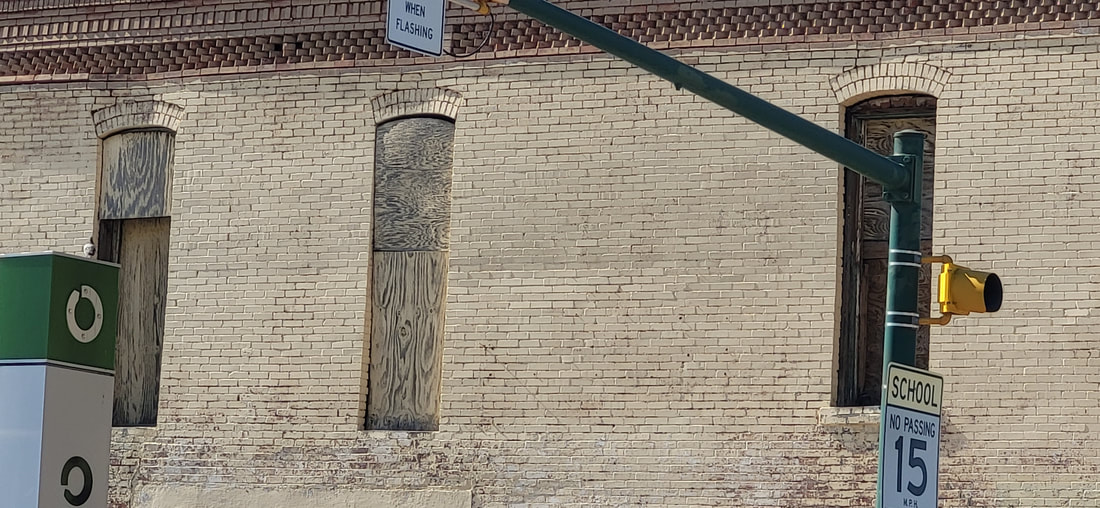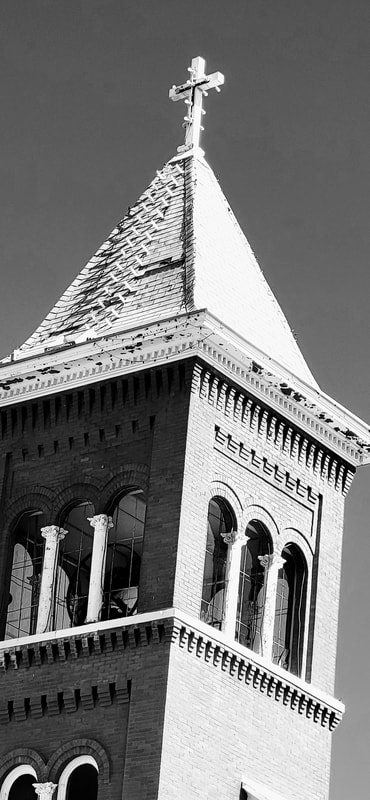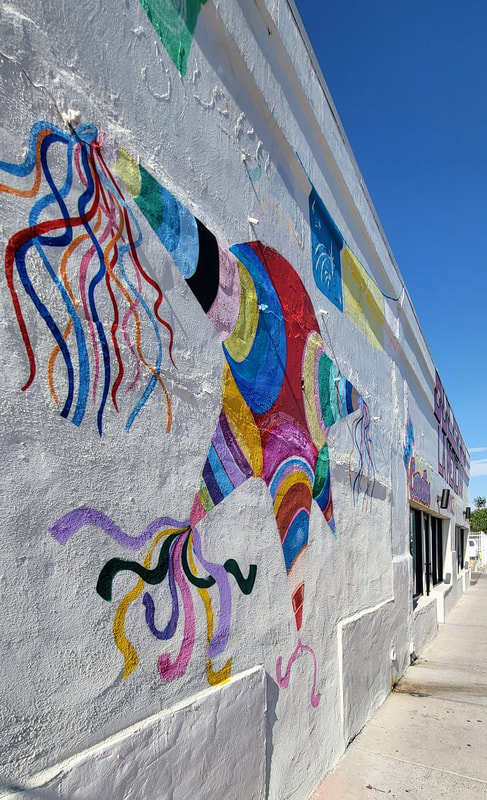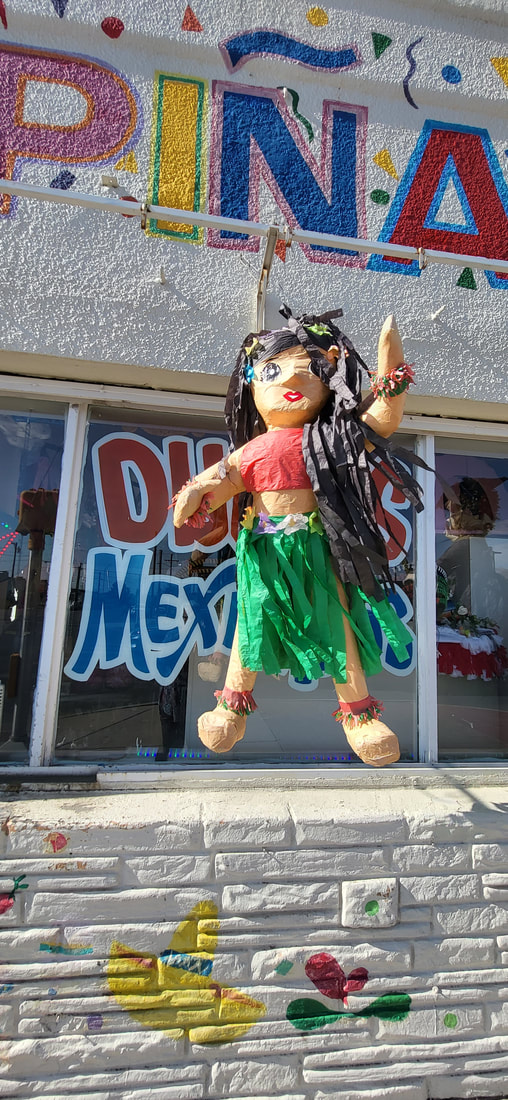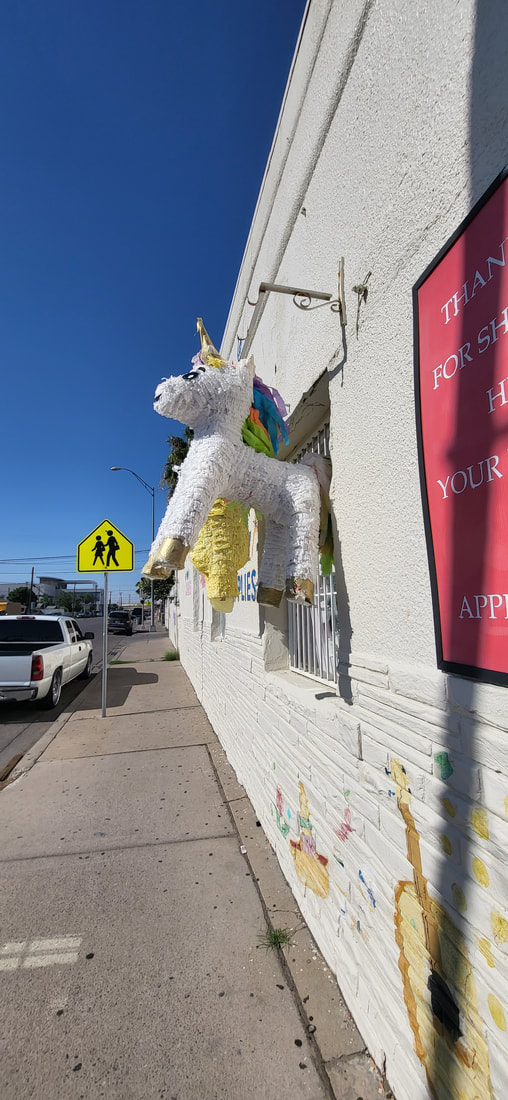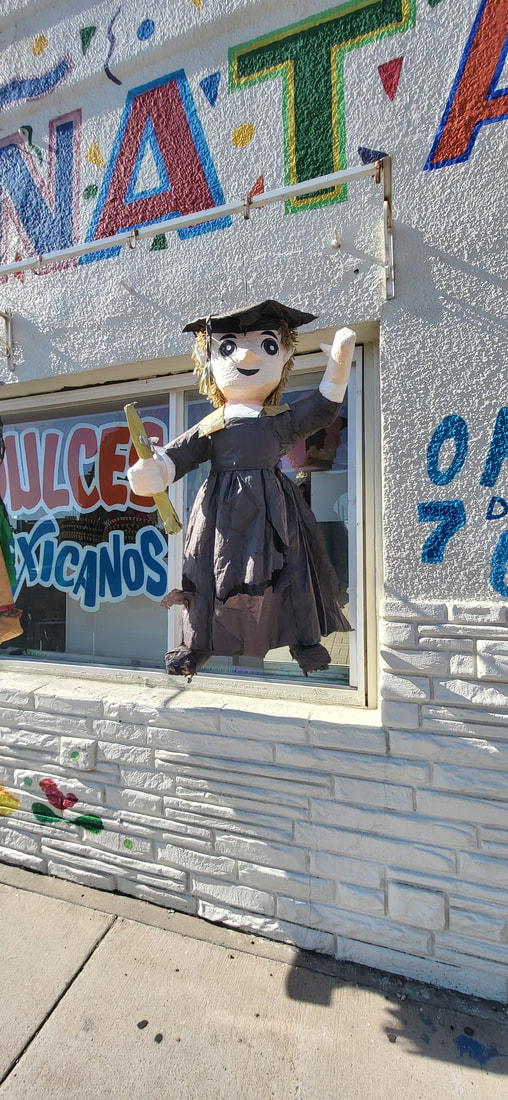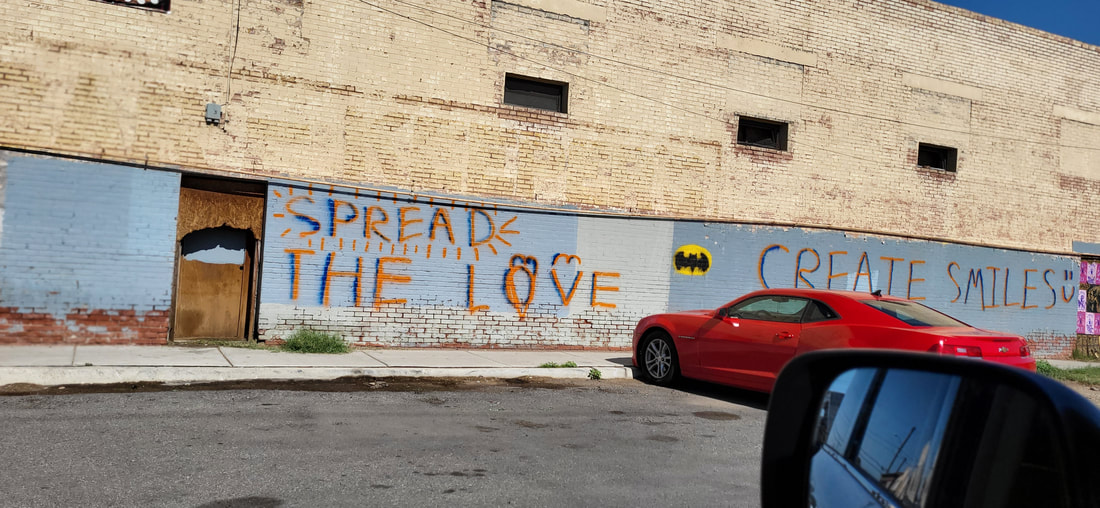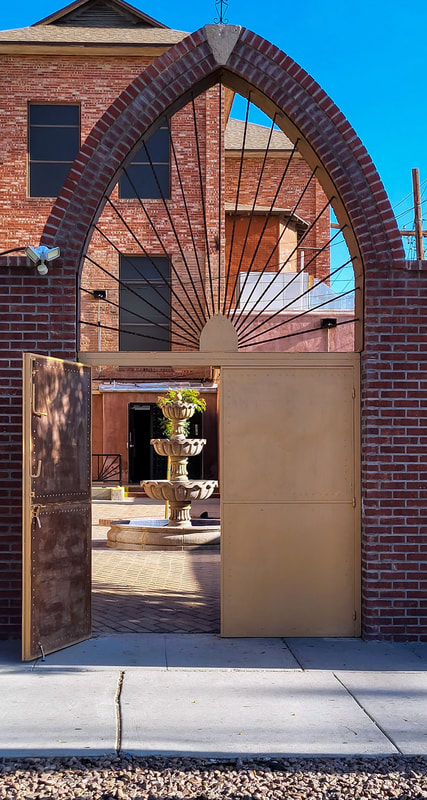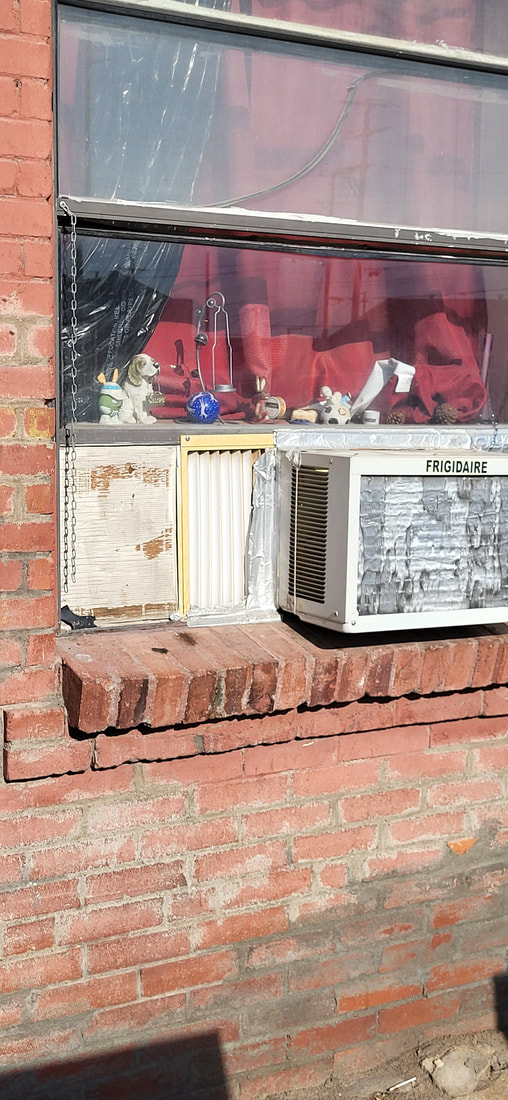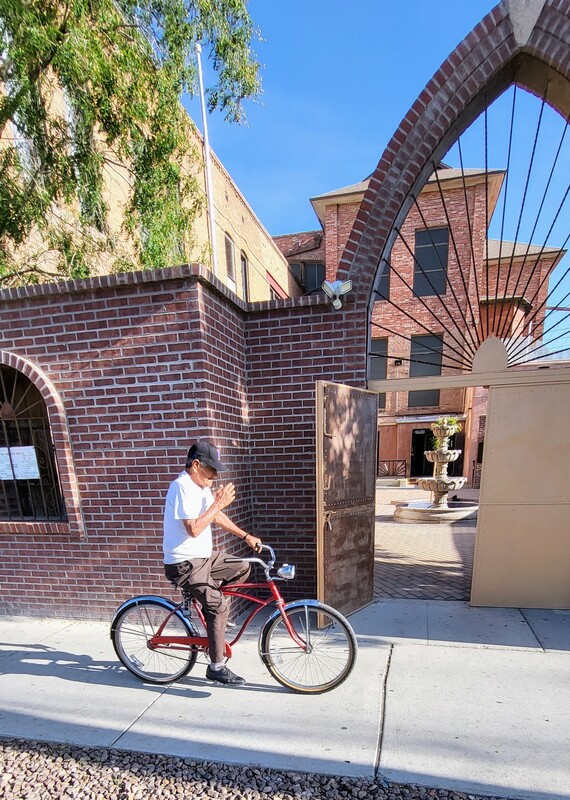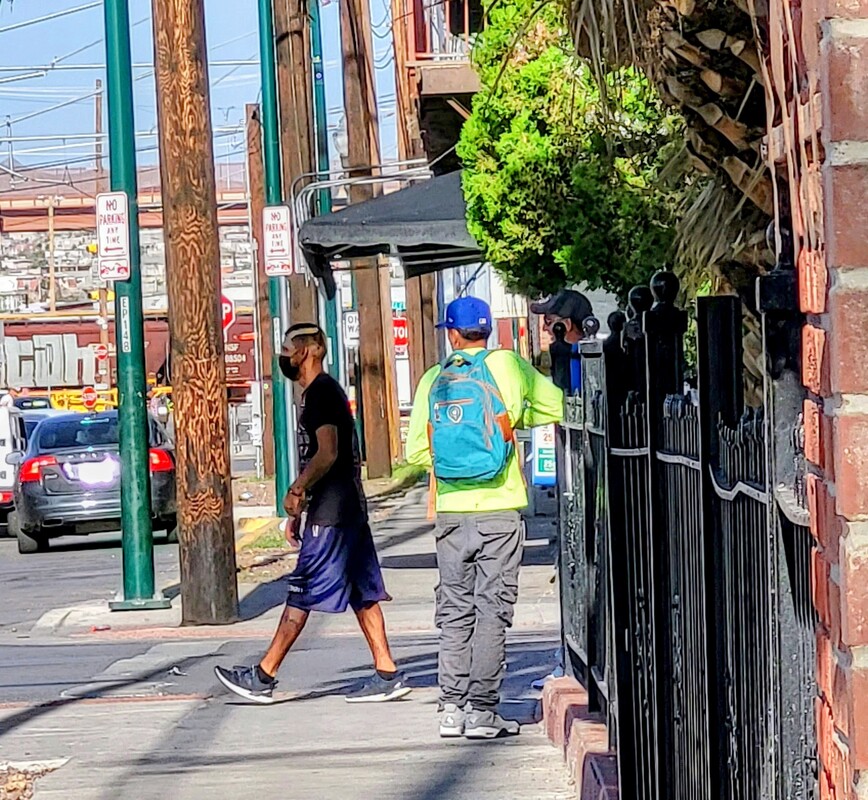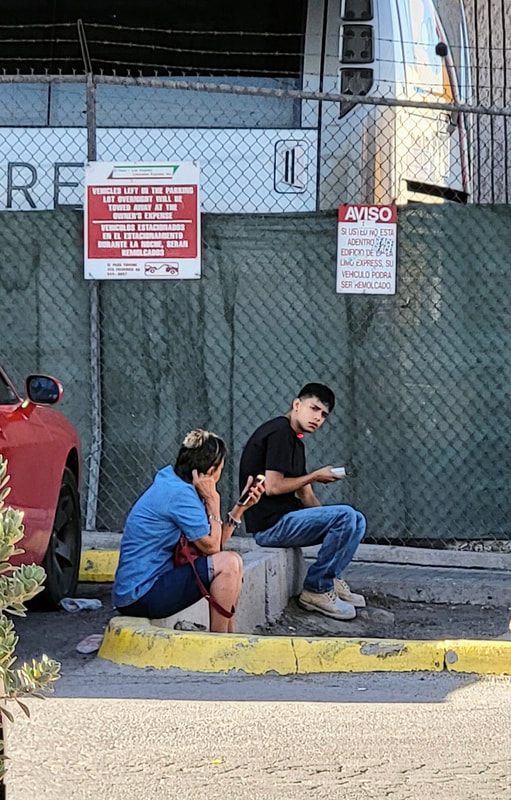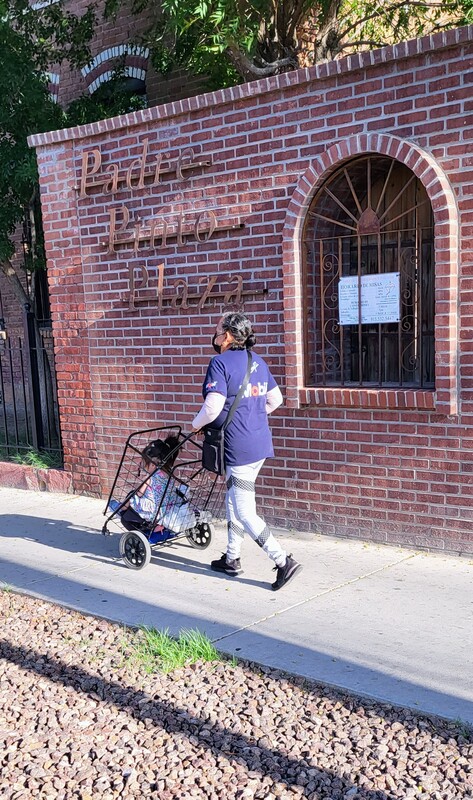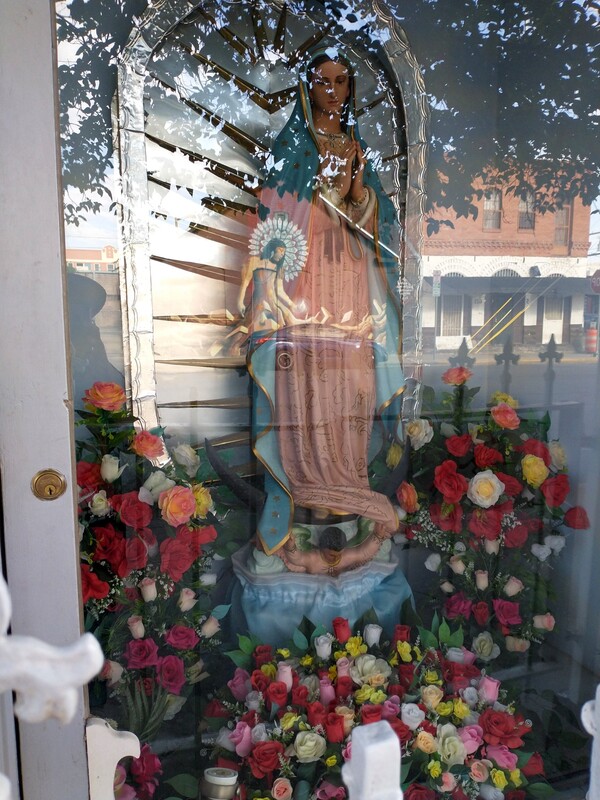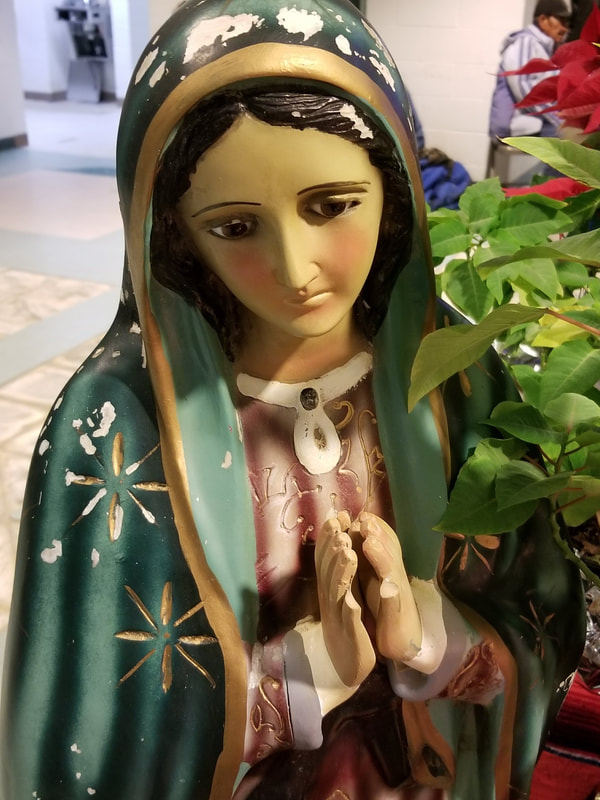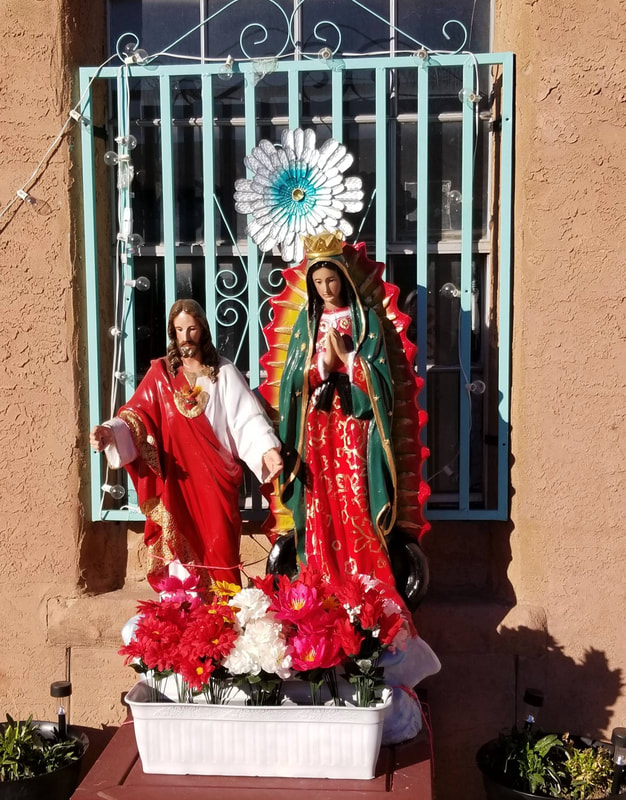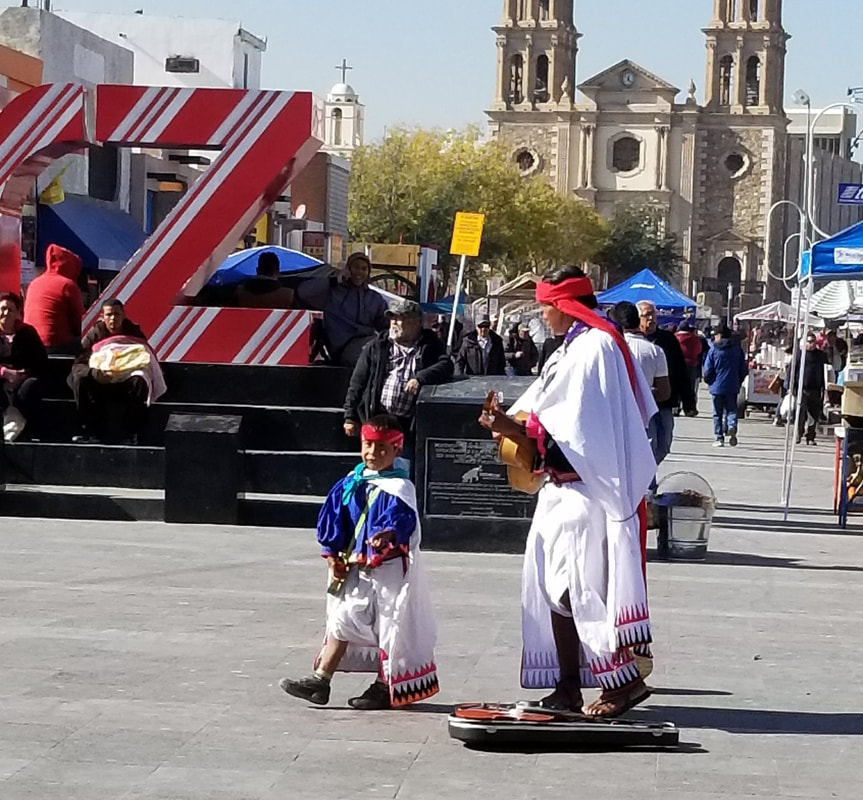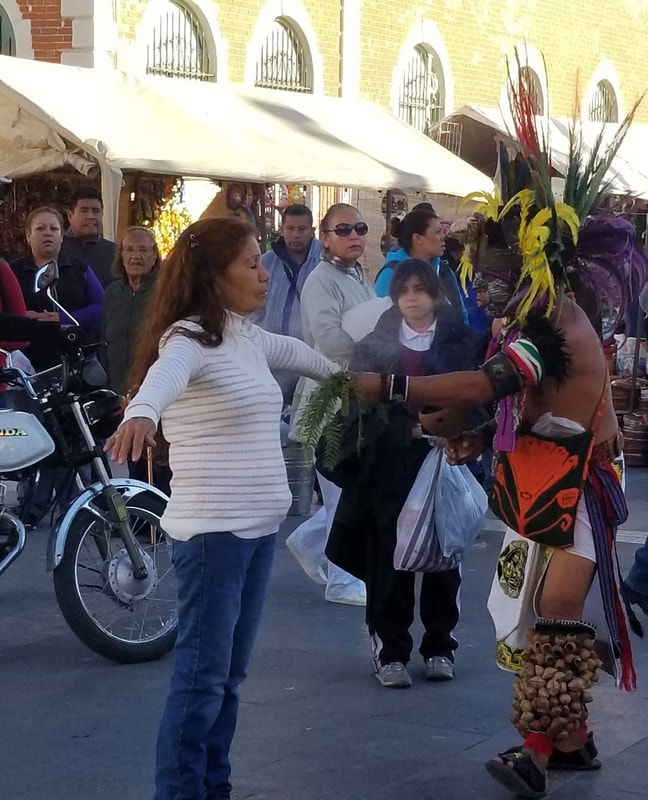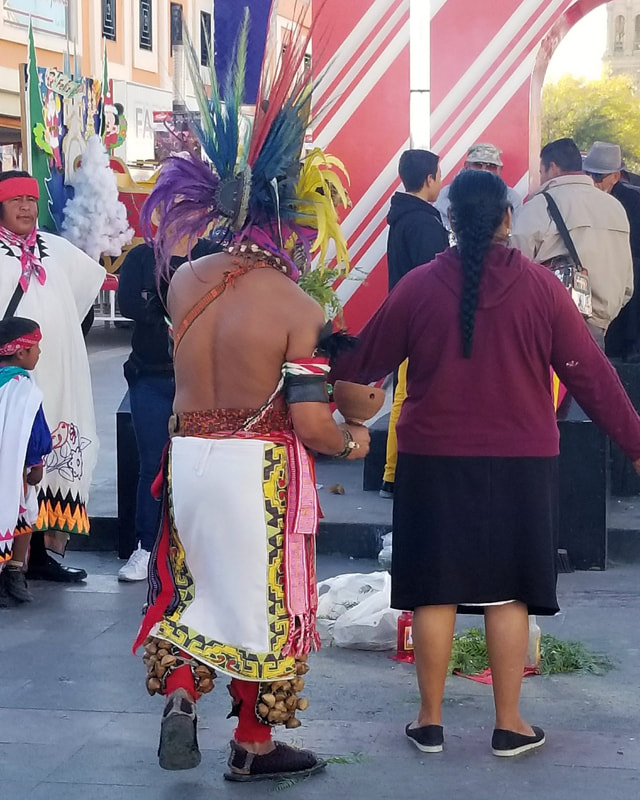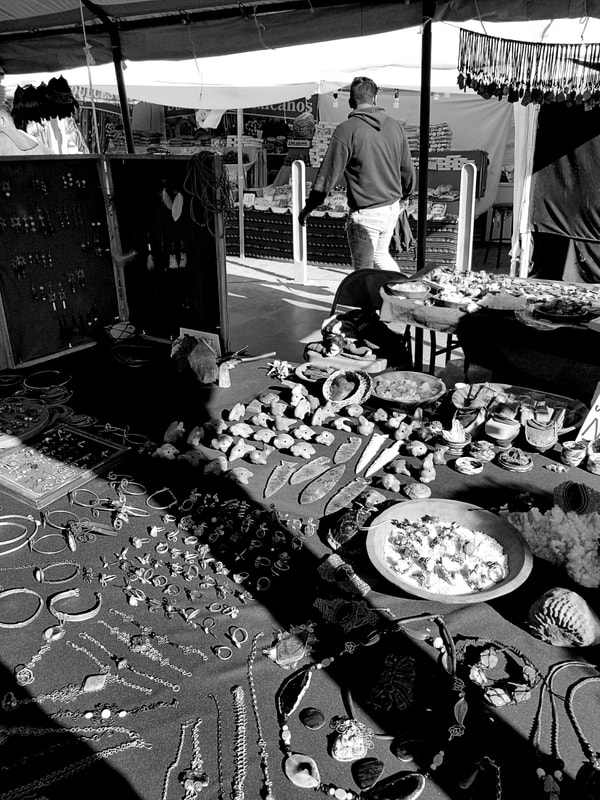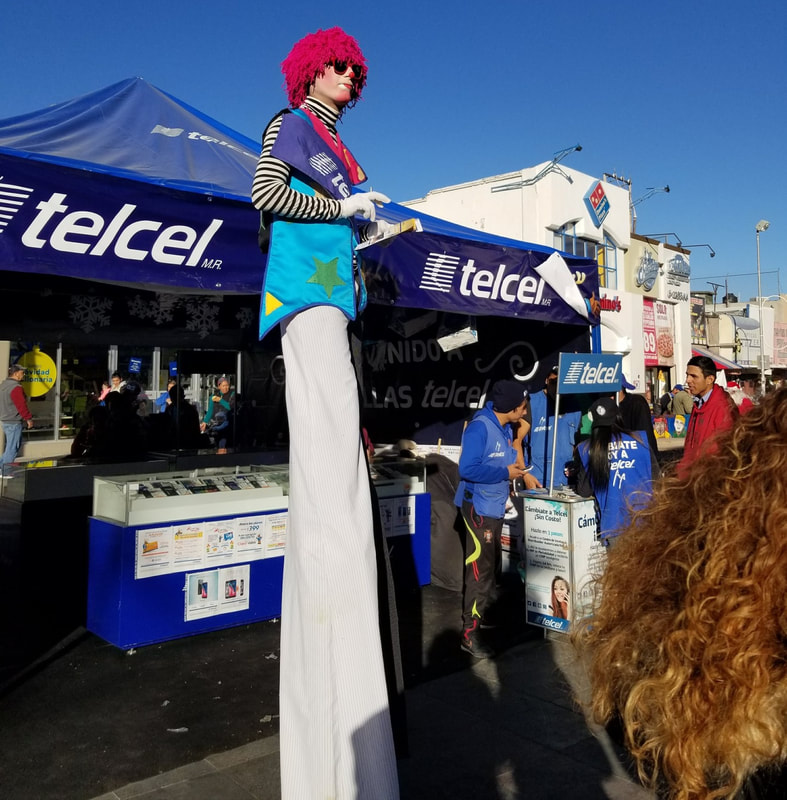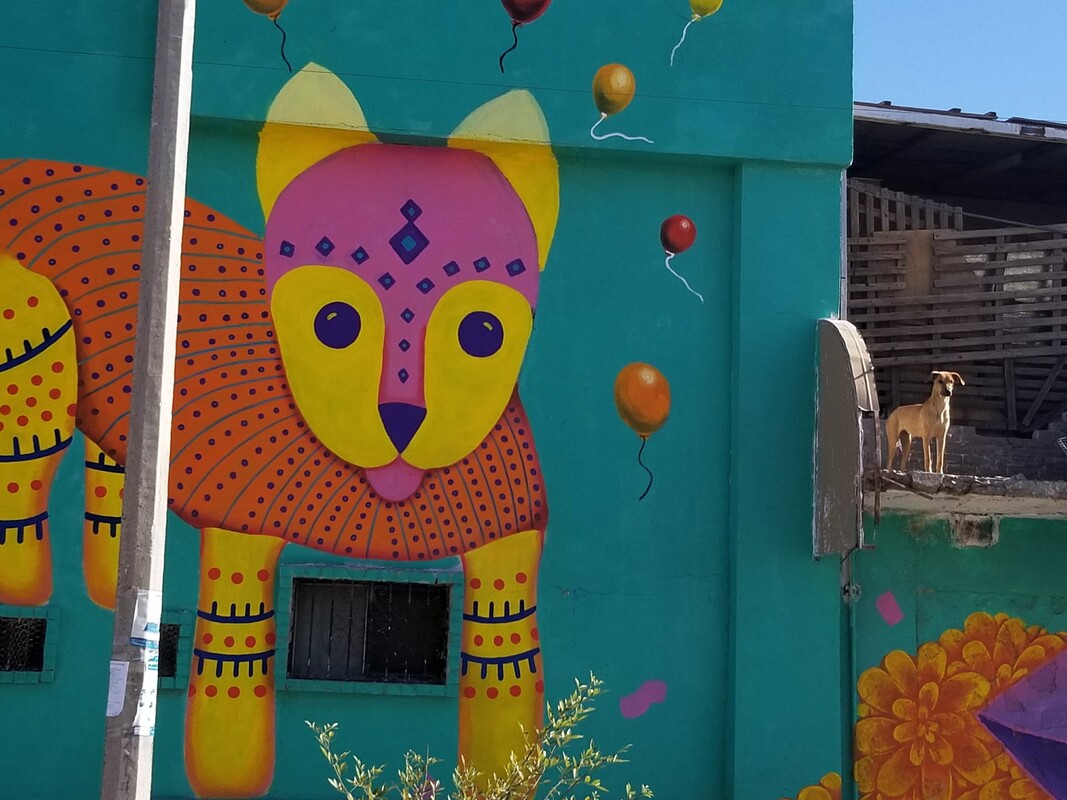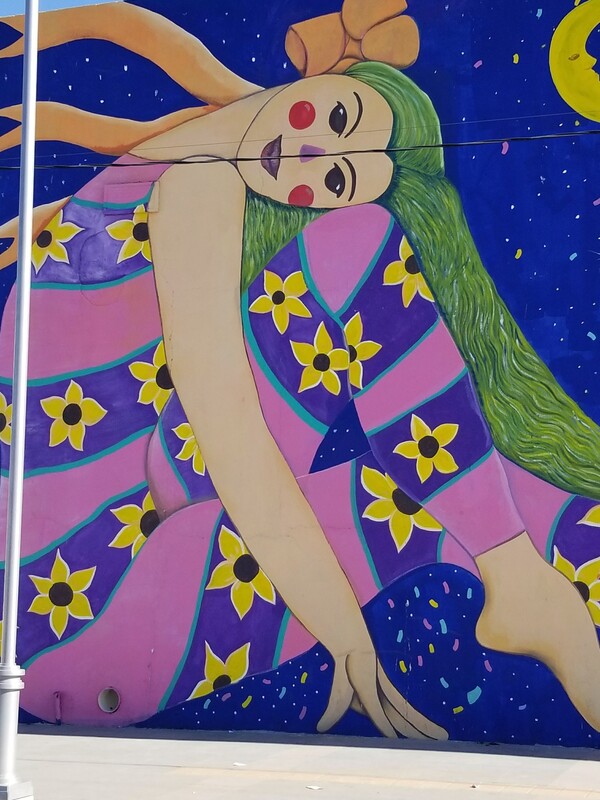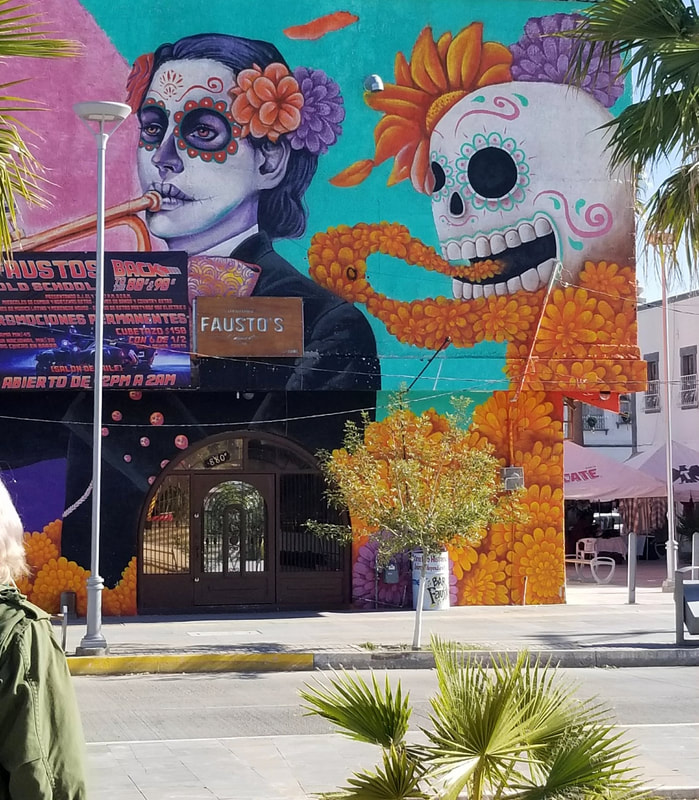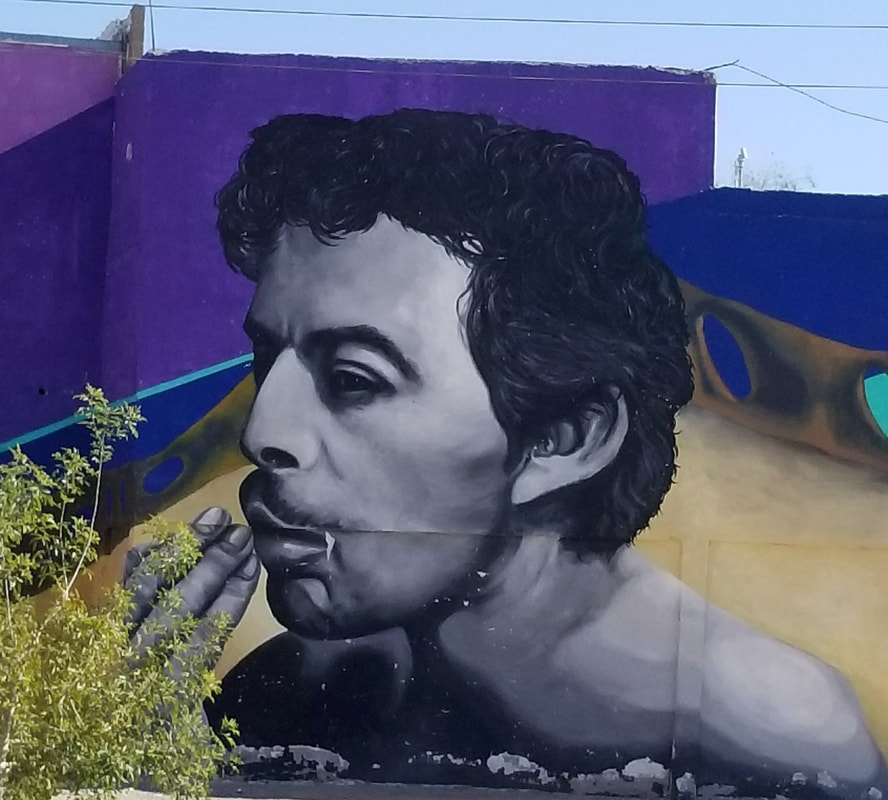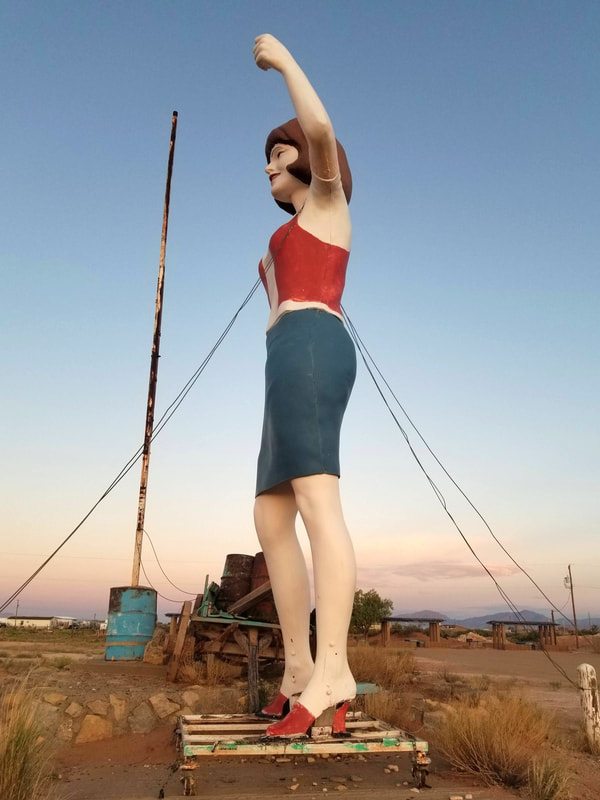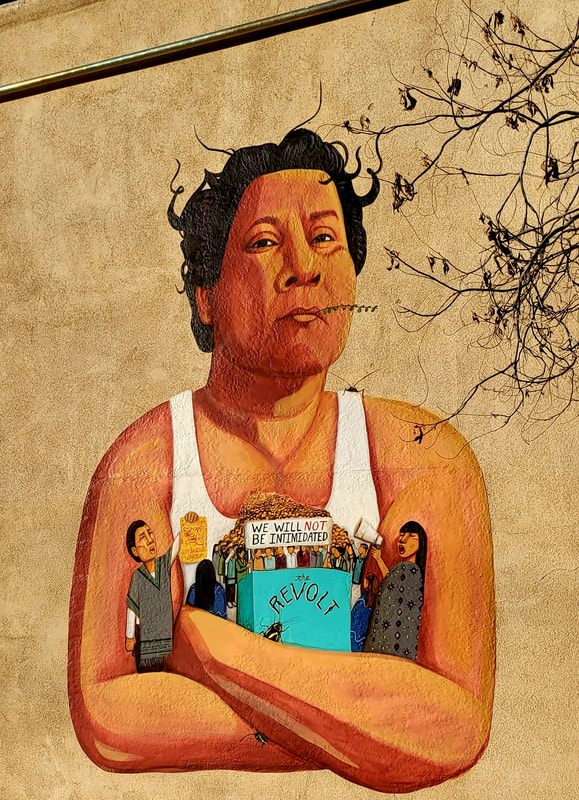|
I didn't mean to stare at him, but I did, drawn in by the deep rich purple of his zoot suit and his calcos, and his black tanda with a feather. I stood behind him in line at the cafe at Sagrado Corazon Catholic Church. I never saw his face but I liked that. He represented more than just a man dressed in a beautiful zoot suit. He represented communal memory and history to me. I don't know when I first knew about the zoot suit, but I grew up hearing Caló, that beautiful mixture of Nahuatl, Romani, and archaic Spanish. And I grew up hearing about the pachucos who first started in El Paso. In a 1978 oral history with Geronimo Leyva, born in 1910 and raised in El Paso from the age of 4, he talked about the migration of young men from El Paso to Los Angeles in the late 1920s and early 1930s. "Entonces oía decir yo mucho de los chamacos, los chavalos, teenagers. Decian 'Pa' dónde vas? "Pa' Los’ y ‘Pa' Los’ y ‘Pa dónde vas?’ y ‘Pa' Los.' Puro "Los." Ninguno decía que para Chicago o otra parte. Pur ‘Los’ y que ‘Los Angeles’… You know what? Ir a sufrir los pobres porque no se ponían a trabajar. Del modo que Vivian los pobresitos no más se iban a la city market a buscar bananas, old bananas, old rotten apples y todo para vivir. Para estar comiendo durante los días. Yo los llegué a verlos, los pobres." My father would tell me the stories of how these young men who had gone to "Los" and suffered would say return to El Paso during the Great Depression, riding the boxcars and saying, "Vamos pa' Chuco." While many people think El Paso's nickname, El Chuco came from pachuco, it is reversed. Returning home, they became los "vamos pa'Chucho." My childhood cartoons even featured the zoot suit. Although some had been made a decade before I was born, they still lived on our black and white television set. This is a poster for 1944 The Zoot Cat. The poster art copyright is believed to belong to the distributor of the film, the publisher of the film or the graphic artist. From Wikipedia. Of course, growing up I heard about German Valdes, "Tin Tan," perhaps the most famous pachuco of his time. When Dr. David Dorado Romo and I founded and directed Museo Urbano in El Segundo Barrio, many of the older women told me that they had been his girlfriend. My own mama, in fact, talked about going to Juarez to see him perform and his asking her on a date. Of course, she was already married to my father so nothing happened. Once, walking in downtown Mexico City, a man selling photos of revolutionaries and movie stars handed me a photo of German Valdes in a zoot suit."Ud. sabe quien es?" "Pues, es Tin Tan," I answered. "Como sabe eso?" "Soy del Chuco," I told him and we both laughed. Tin Tan and his friend, Marcelo. 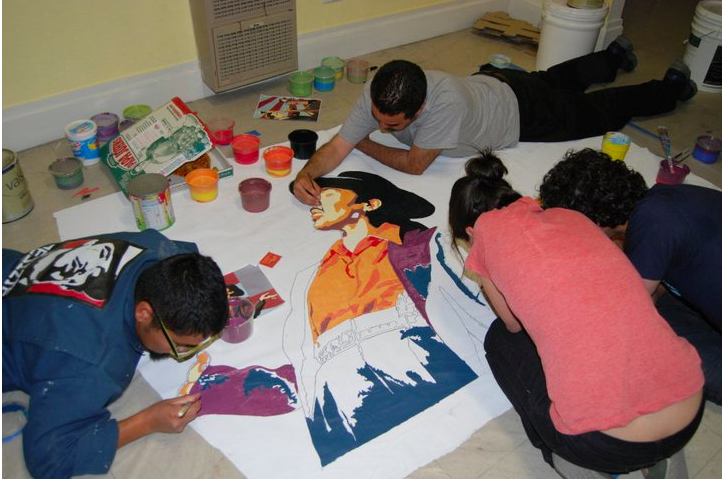 David Flores of Colectivo Rezizte (left), Antonio Lopez (top right), Maru Lopez and Eddie Garcia (bottom right) paint "Pachucos Suaves" in El Segundo Barrio, 2011. In 2010, David Romo and I commissioned a mural for UTEP's Museo Urbano. Internationally-recognized muralist whose work was recently featured at the Smithsonian Cooper Hewitt Design Museum in NYC, David Flores designed and painted the mural. The mural, Pachucos Suaves," featured the archetypal pachuco seen above as well we Edmundo Tostado aka Don Tosti, the famous musician and composer who in the 1940s wrote "Pachucos Suaves," earning him the title of the first Latino to sell a million records. 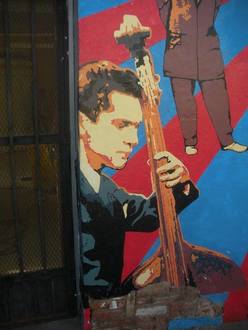 Don Tosti as portrayed on the "Pachucos Suaves" mural. He was born and raised in El Segundo Barrio and, much like the "chavalos" from the oral history quoted above, moved to "Los" as a young man to make his way in the world. Unlike the teenagers who had to look for old fruit to eat, he became a very successful musician and composer. 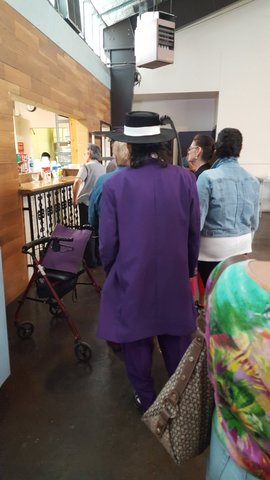 The man in the purple zoot suit gave me much to remember and think about as he stood in line for menudo Sunday morning. What about the zoot suit still captures our imagination so many decades later? How is that history passed on from generation to generation? Why does this outfit resonate with so many so many decades later? I didn't mean to stare at him, but I did as he walked along the streets of El Segundo, the home of the pachuco. [Oral history excerpt taken from interview of Geronimo Leyva by Yolanda Leyva, May 1978, deposited at the Benson Latin American Library, the University of Texas at Austin.].
20 Comments
Simon Patchin
4/1/2021 02:38:18 pm
I was married for 16 years to a loving wife and mother. We had 2 children together who are now 11 & 13. I reconnected with an old girlfriend from college on Facebook and we began an affair and I left my wife. The woman I had an affair with is a wonderful woman and I love her too and our kids had begun accepting the situation and my wife has kind of moved on, but not in love with the man she is seeing. I thought I fell out of love with my wife and I felt terrible about what I did to her - she is a good woman and I don't know what came over me. I decided to try and get her back and I was recommended to Lord Zakuza for help to get reunited with my wife and within 48 hours after I made contact with Lord Zakuza my wife decided to work things out with me and now we are back together with our children living as one happy family. I really don't know the words to use in appreciation of what Lord Zakuza did for me but I will say thank you sir for reuniting I and my family back. For those in trying times with their marriages or relationship can WhatsApp Lord Zakuza for help or text with this number +1 (740) 573-9483 or you can send him an email to [email protected]
Reply
Aristide Mboneye
8/16/2022 05:56:48 am
My wife and I will forever remain grateful to Dr Amber for his divine intervention in our lives. My wife and I fled from Burundi to Australia. We got to Australia and life was quite ok but we needed more funds to clear our bills. My wife did some research online to get help in winning the lottery and she got credible recommendations of Dr Amber who gives out lottery winning numbers with his magical spell. We got in touch with Dr Amber and he assured us that he can help us if only we believe in his work. We agreed to proceed with him and we bought one ticket in the Hospital Research Foundation Home lottery and played it just as Dr Amber instructed with the numbers he gave to us and within 5 days, we received the shock of a lifetime when we realized we've won a $3 million dollars house and $1 million dollars cash in the lottery. We want everyone to join us to appreciate Dr Amber. To know more, visit: amberlottotemple.com or call/text +18084815132 or email: [email protected]
Reply
Julianna Davis
7/6/2023 06:13:34 pm
i want to share to the whole world how Dr Kachi the Great of all the Spell Caster, that helped me reunite my marriage back, my Ex Husband broke up with me 3months ago, I have been trying to get him back ever since then, i was worried and so confused because i love him so much. I was really going too much depressed, he left me with my kids and just ignored me constantly. I have begged him for forgiveness through text messages for him to come back home and the kids crying and miss their dad but he wont reply, I wanted him back desperately. we were in a very good couple and yet he just ignores me and get on with his life just like that, so i was looking for help after reading a post of Dr Kachi on the internet when i saw a lady name SHARRON testified that Dr Kachi cast a Pure love spell to stop divorce. and i also met with other, it was about how he brought back her Ex lover in less than 24 hours at the end of her testimony she dropped his email, I contacted Dr Kachi via email and explained my problem to Dr Kachi and he told me what went wrong with my husband and how it happen, that he will restored my marriage back, and to my greatest surprise my Ex husband came back to me, and he apologized for his mistake, and for the pain he caused me and my children. Then from that day our marriage is now stronger than how it was before, Dr Kachi you're a real spell caster, you can also get your Ex back and live with him happily: Contact Email [email protected] his Text Number and Call: +1 (209) 893-8075 his Website: https://drkachispellcaster.wixsite.com/my-site
Reply
William Smith
8/15/2023 09:23:49 am
“I recently enlisted one of personal chargeback recovery services and I must admit I was more than impressed. If you have been a victim of bitcoin or any cryptocurrency scam, I feel like it's my duty to connect you all with a legit hacker like him. I started having a lot of issues with an investment company that goes by the name drip coin when I placed a withdrawal order for 297,000 USD I had with them. The so-called accountant disappeared, the support team did not respond to any of my emails and I thought it was over because I made the payments in crypto but I didn’t give up to have my funds back. Luckily for me with the help of WIZARD WITHNEY BLOCKCHAIRHACK SERVICE I was able to recover my funds. I salute him for his service and I write to others who might need his help in getting their funds back from such companies. His personal info is: Wizardwithneyblockchairhackser(@) gmail(.)com, that is a means you can reach them on.
Reply
Petra Nika
11/22/2023 01:05:03 pm
I never thought I will smile again after my husband left me with two kids for over a year. All effort to bring him back failed and we had problems agreeing on anything. My fear was that I'm not going to see him again until I met a lady called Dora on the internet who told me about the great works of Dr Ilekhojie who have helped so many people with same case as mine. She gave me his contact and i spoke to him immediately. Dr Ilekhojie assured me that it is just a lost connection between us and promised that after a reconciliation is done, the connect between me and my husband will be repaired and he will return on his own. Juts as he promised, my husband called the third day and asked to return home. I'm still surprise till now about this miracle, because it just too real and i am happy that i trusted Dr Ilekhojie to help me. I leave his contact here for anyone who has problems in marriage or relationship. Email: [email protected] whatssap +2348147400259
Reply
12/27/2023 02:34:18 pm
WHAT TO DO WHEN YOUR CRYPTO IS LOST OR STOLEN // CAPTAIN WEBGENESIS.
Reply
1/12/2024 05:16:58 pm
Reply
1/13/2024 02:20:16 am
Reply
1/15/2024 03:51:10 am
Recovery Lost Funds From Online Scammer's/ Cryptocurrency/ Recovery of Stolen bitcoin / Bitcoin Mining/ Increase your Credit score/ MOBILE SPY REMOTECONTROL ACCESS AUTHORIZATION. Removing Bad Records from Both Public and Private database via Email: [email protected] and website: https://wzardgarryspeedhac.wixsite.com/my-site-1
Reply
Bill
2/6/2024 12:56:55 am
A TRIAL ON THE RESTORATION OF MY MISPLACED BITCOIN FUNDS
Reply
Leonardo Romario
2/6/2024 03:33:38 am
The internet used to be a safe haven to gather new knowledge in the comfort of your space until these scammers sprouted out of the blue like worms and made it unsafe. I am a country music lover, and Kenny Rogers is my idol. I can remember when a notification from Instagram popped on my screen, Guess who, my idol. I was awed and I can remember myself writing about all his impact in my life. I was so sure I was talking to my idol on Instagram. He did say he wanted to introduce me to this quick money-making scheme because he noticed I have been a loyal fan on his official IG page. My idol can never go wrong in my eyes and didn't even do any research. I hurriedly joined the scheme. I never knew it was a scammer posing as a celebrity till I had invested $540.000.00. It got worse when I couldn't access my account or withdraw from my investment, I knew there was a problem after all these happenings. I need to get help from any means to ensure I am not a victim of these parasites. I was glad to be able to be introduced to the best CRYPTOCURRENCY RECOVER EXPERT known as SPYHOST CYBER SECURITY COMPANY. I talked to their representative and they assured me of recovering my stolen investment. And as they promised, they didn't disappoint as they were very confident in their expertise. My stolen investment was successfully recovered and they were the ones who confirmed to me that I was cat-fished. If by chance you are in same dilemma you can contact them through the following channels;
Reply
Annie
3/26/2024 12:58:27 am
Hello, My name is Annie Torres From Canada.
Reply
JAMES smith
4/11/2024 02:23:41 am
"I decided to try out the services of software Specialist, he helps people to recover lost funds. I can vouch for him because I have used him when I lost a considerable amount of money in a dubious online investment. To be honest, I was skeptical at first but to my surprise he was able to recover my lost funds within a few weeks. The guy was professional and efficient in his work and what I liked most about him is that he kept updating me on the process of recovering my lost funds. Till today all I do is appreciate his generosity and that is why I decided to give this information to the public of how good he renders his services. Contact him on his mail on [email protected] OR CALL OR TEXT +1(716) 318-5536 for great hacking services."
Reply
Taelaeia Johnson
4/20/2024 09:17:47 am
Hi everyone, I made a promise to myself that I was going to come back here and testify about the great job [email protected] did for me with their magnificent hacking skills, they didn’t just get back my scammed money i invested with a fake investment company that was almost $520.000 but to my greatest surprised I got back the money I invested but they also use their sophisticated skills to get even more than the money I invested that was found in the hackers wallet during the period of recovery back my funds which was even more than I expected. If you have been wondering and looking for a way to get back your scammed funds of any kind, I will suggest you quickly get in contact with [email protected] or you can also get in touch with them through WhatsApp on +1 (786) 684‑0501
Reply
Brittany Stephanie
4/20/2024 09:19:16 am
Wow I have been seeing people testimonies on how SWIFT ASSETS RECOVERY SERVICE help them to recover back their scammed funds back just within short period of time and I was amaze and decided to also give them a try and to my greatest surprise I was able to get back my funds back just under 72 hours of reaching out to [email protected] all thanks to the team for doing a very good job and keeping to their words and you can also reach them through their WhatsApp on +1 (786) 684‑0501
Reply
Jonathan Alex
4/24/2024 01:40:06 am
It's very important to research properly before deciding to invest in cryptocurrency trade. I lost all my crypto funds after falling victim to a crypto scam. Luckily for me, I was able to recover my funds after stumbling on a post made by someone online about CAPTAIN JACK CRYPTO RECOVERY, this crypto recovery company was able to recover my stolen crypto within 42 hours. I’m super excited and glad that I was able to get the help that I needed and I recommend their service to everyone out there. They can be reached through the link below.
Reply
Paul
5/28/2024 03:50:22 pm
If you're not familiar with cryptocurrency trading, I strongly advise you to either stay away from it completely or invest very cautiously. I was forced to invest a significant amount of my life savings on a forex platform to increase my profits, but I ultimately lost roughly 95,000 USD to this investment scam. I was not allowed to take my money out after I had invested and made a profit. I sent a letter to customer service, but it was ineffective, so I realized I had been duped. I was fortunate enough to come across a genuine deal retrieval WEB WIZARD after much looking for ways to acquire assistance. I decided to give it a shot and explained my condition to them. they gave me their word that they would help me get my money back. Honestly, they performed a fantastic job, and my money was recovered in my wallet in less than 24 hours without any upfront payment. I appreciate having encountered WEB WIZARD with such exceptional abilities, it's truly remarkable.
Reply
oliver william
6/10/2024 06:44:22 pm
Contact Vacumm Cyber Hackers: Crypto And Digital Asset Recovery Team
Reply
Recovery Intelligence
6/12/2024 09:05:51 am
ARE YOU A VICTIM OF INVESTMENT OR NFT SCAM? DO YOU WANT TO INVESTIGATE A CHEATING SPOUSE? DO YOU DESIRE CREDIT REPAIR (ALL BUREAUS)? SCHEDULE A MEETING WITH AN ETHICAL HACKER ASAP TO GET STARTED.
Reply
Judith Allen
6/29/2024 01:26:47 pm
Regarding funds and crypto recovery, I found DECODE HACKER very helpful. I am Allen from Singapore and here is my story. In early 2022, I managed to build huge savings from 2020 from my remote working-from-home online business. When huge inflation was speculated early in 2022, I knew I had to jump into an investment opportunity to reap huge benefits. Cryptocurrency, specifically Ethereum and BTC, were my main focus. I made a quick huge investment ($ 202,700) in the two. Fast forward to a time when I needed to do withdrawals with my investors, but like most people, this firm denied my withdrawals. I had to act fast! So when my deep research came to Decode Hacker, I wasted no time. They had a 4.7 rating and that was more than enough. In a day, they recovered $199,960 which was way more than my expectations. Bigup Decode Hackers.
Reply
Leave a Reply. |
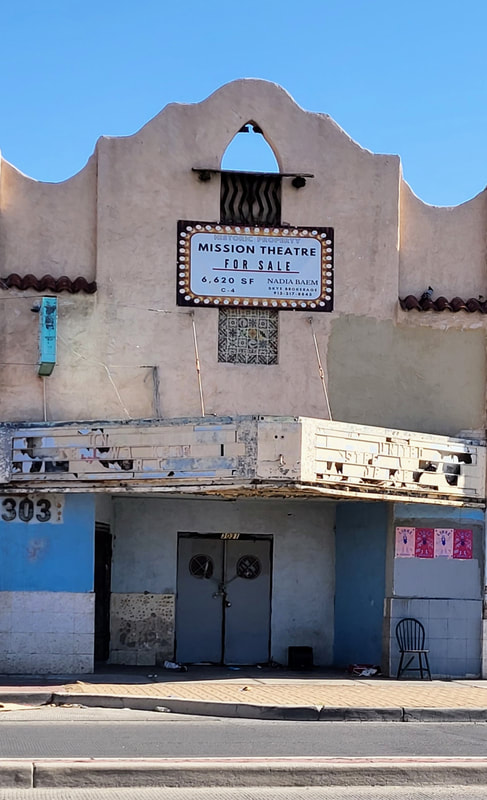
My father used to tell me about sneaking into this theater to watch movies as a kid in the 1910s. It showed Spanish language films. In the 1940s, it was transformed into a "whites only" theater but that didn't last long. By the 1950s, it was headquarters to the Mine, Mill, and Smelter Workers Union, a radical labor organization. Before it closed, it housed the Mine and Mill Bar.
Segundo Barrio
Father Rahm Street
July 2022
La Virgensita en la frontera
Cd Juarez downtown
December 2017
La Mariscal, Ciudad Juarez, 2017
Montana Vista 2019
El Centro July 2022
